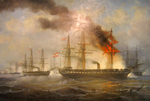Portal:Denmark/Selected article/Week 13, 2007

The Battle of Heligoland (or Helgoland) was fought on 9 May 1864 during the Second War of Schleswig between the navy of Denmark and the allied navies of Austria and Prussia south of the then-British North Sea island of Heligoland. When the Danish forces had caused the flagship of the Austrian commander, Freiherr von Tegetthoff, to burst into flames, he withdrew his squadron to neutral waters around Heligoland. It was the last significant naval battle fought by squadrons of wooden ships and also the last one involving Denmark.
Although the battle ended with a tactical victory for Denmark, it had no impact on the outcome of the war. A general armistice came into effect on 12 May, and Denmark had lost the war.
Following the outbreak of war on 1 February 1864, Denmark declared a naval blockade against all ports in Schleswig-Holstein on 26 February and extended it to all Prussian ports on 8 March. The blockade was initially enforced by the steam-powered 42-gun screw frigate Niels Juel and shortly thereafter also by the screw corvette Dagmar.
Having only a very small navy of her own, Prussia requested Austrian assistance, and in early March two screw frigates, Schwarzenberg (51 guns) and Radetzky (37 guns), and the gunboat Seehund left the Mediterranean under the command of Captain von Tegetthoff.
To counter this threat, Denmark formed a North Sea Squadron under Captain Edouard Suenson, comprising Niels Juel, Dagmar and the 16-gun screw corvette Hejmdal. Its orders were to protect Danish merchant shipping, capture German ships, and confront enemy warships in the North Sea. Dagmar was soon replaced by the 44-gun screw frigate Jylland.
